Principles of Business Report: Understanding Business Principles
VerifiedAdded on 2020/06/03
|10
|3333
|73
Report
AI Summary
This report delves into the fundamental principles of business, providing a comprehensive overview of key concepts and practical applications. The report begins by examining the characteristics of different business markets, including B2B, industrial, professional services, and government sectors, and explores the nature of interactions between businesses. It then investigates how organizational goals are shaped by market dynamics and outlines the legal obligations businesses must adhere to. The report proceeds to define business innovation, analyzing the use of innovation models and sources of support, and explains the product or service development process. It also discusses the benefits, risks, and implications associated with innovation. Furthermore, the report covers financial management, emphasizing the importance of financial viability, the consequences of poor financial decisions, and different financial terminologies. It also explains business budgeting, including budget management techniques. Finally, the report explores sales and marketing, detailing the principles of marketing, the sales process, the features and uses of market research, the value of branding, and the relationship between sales and marketing. The report concludes by summarizing the key takeaways and providing references for further study. The report uses examples from the radio industry to illustrate how these principles are applied in practice.
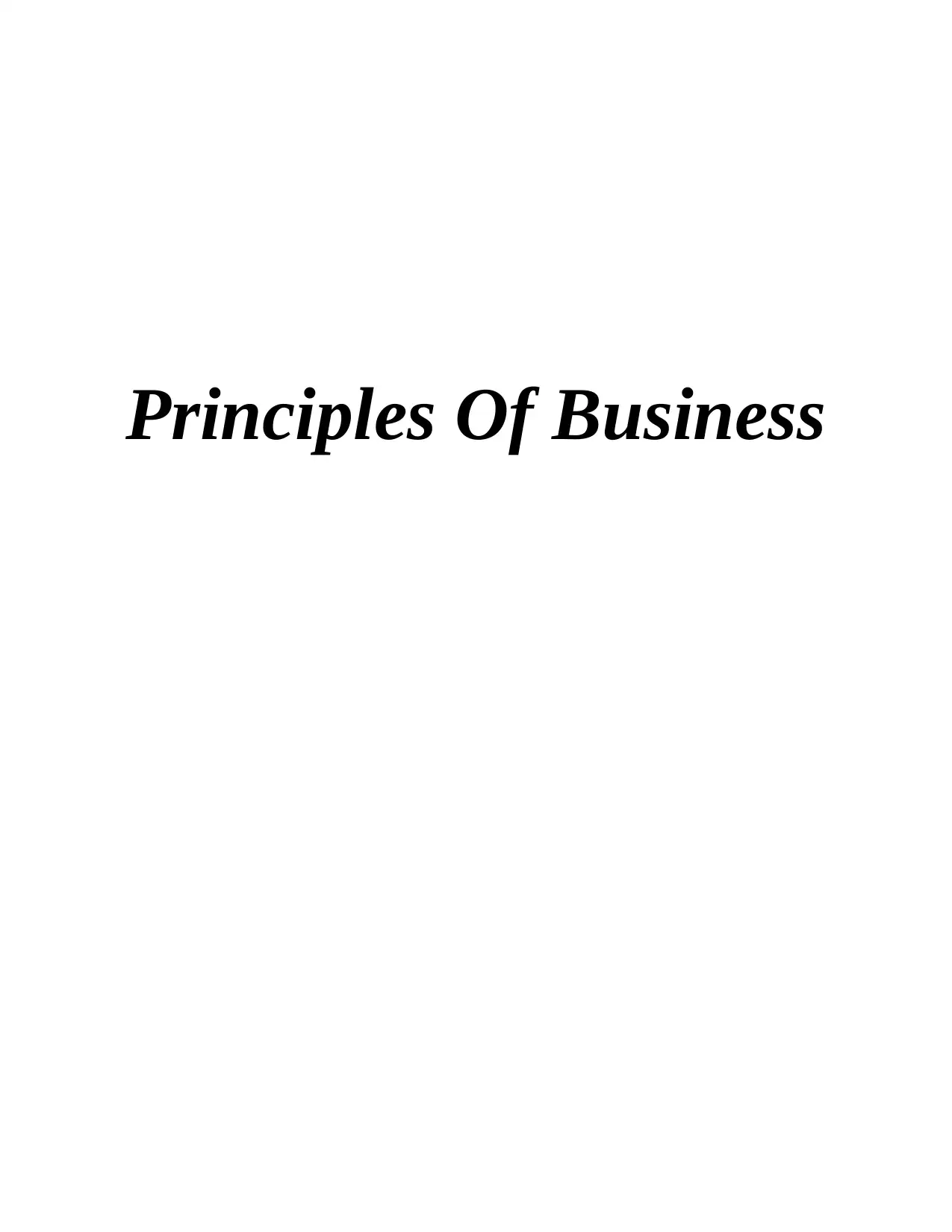
Principles Of Business
Paraphrase This Document
Need a fresh take? Get an instant paraphrase of this document with our AI Paraphraser
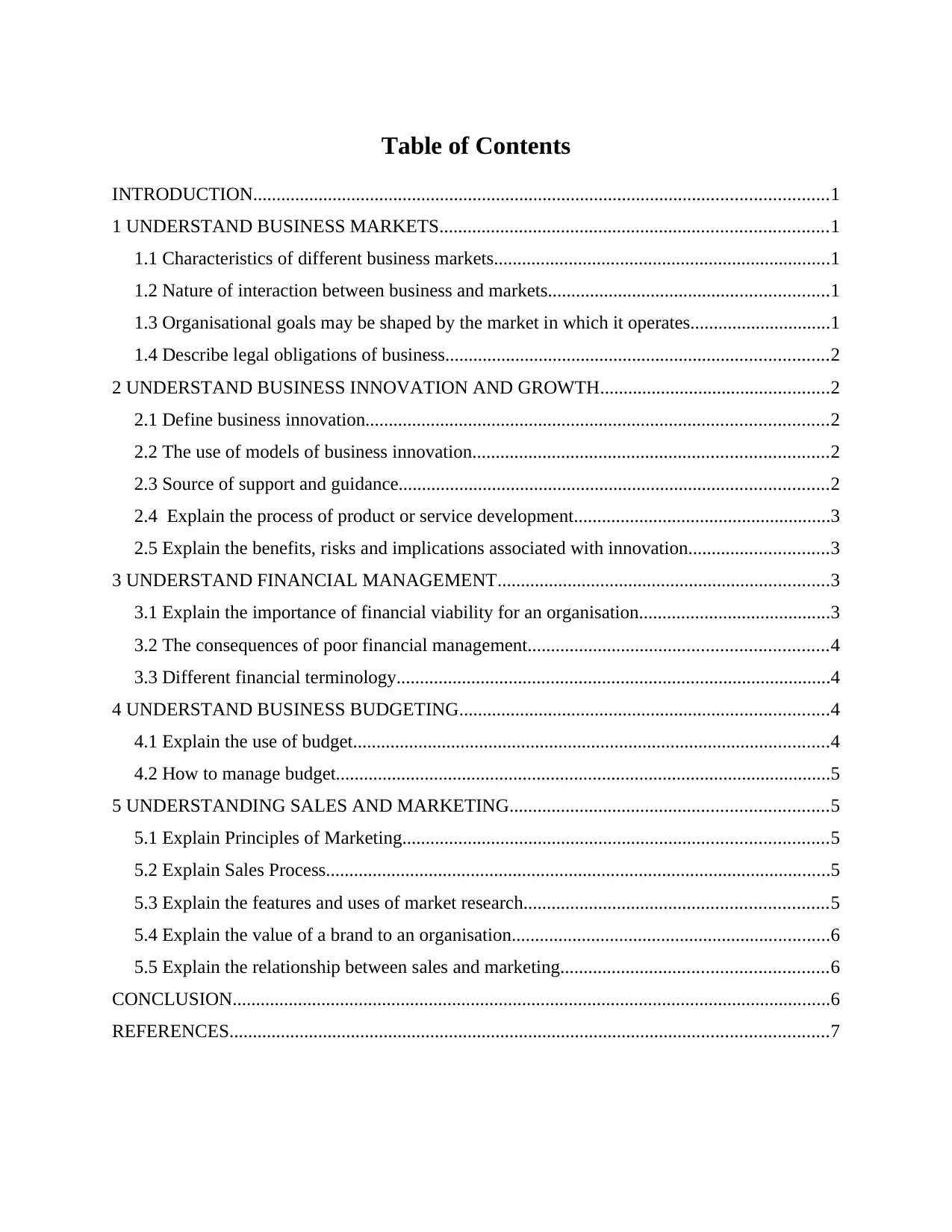
Table of Contents
INTRODUCTION...........................................................................................................................1
1 UNDERSTAND BUSINESS MARKETS...................................................................................1
1.1 Characteristics of different business markets........................................................................1
1.2 Nature of interaction between business and markets............................................................1
1.3 Organisational goals may be shaped by the market in which it operates..............................1
1.4 Describe legal obligations of business..................................................................................2
2 UNDERSTAND BUSINESS INNOVATION AND GROWTH.................................................2
2.1 Define business innovation...................................................................................................2
2.2 The use of models of business innovation............................................................................2
2.3 Source of support and guidance............................................................................................2
2.4 Explain the process of product or service development.......................................................3
2.5 Explain the benefits, risks and implications associated with innovation..............................3
3 UNDERSTAND FINANCIAL MANAGEMENT.......................................................................3
3.1 Explain the importance of financial viability for an organisation.........................................3
3.2 The consequences of poor financial management................................................................4
3.3 Different financial terminology.............................................................................................4
4 UNDERSTAND BUSINESS BUDGETING...............................................................................4
4.1 Explain the use of budget......................................................................................................4
4.2 How to manage budget..........................................................................................................5
5 UNDERSTANDING SALES AND MARKETING....................................................................5
5.1 Explain Principles of Marketing...........................................................................................5
5.2 Explain Sales Process............................................................................................................5
5.3 Explain the features and uses of market research.................................................................5
5.4 Explain the value of a brand to an organisation....................................................................6
5.5 Explain the relationship between sales and marketing.........................................................6
CONCLUSION................................................................................................................................6
REFERENCES................................................................................................................................7
INTRODUCTION...........................................................................................................................1
1 UNDERSTAND BUSINESS MARKETS...................................................................................1
1.1 Characteristics of different business markets........................................................................1
1.2 Nature of interaction between business and markets............................................................1
1.3 Organisational goals may be shaped by the market in which it operates..............................1
1.4 Describe legal obligations of business..................................................................................2
2 UNDERSTAND BUSINESS INNOVATION AND GROWTH.................................................2
2.1 Define business innovation...................................................................................................2
2.2 The use of models of business innovation............................................................................2
2.3 Source of support and guidance............................................................................................2
2.4 Explain the process of product or service development.......................................................3
2.5 Explain the benefits, risks and implications associated with innovation..............................3
3 UNDERSTAND FINANCIAL MANAGEMENT.......................................................................3
3.1 Explain the importance of financial viability for an organisation.........................................3
3.2 The consequences of poor financial management................................................................4
3.3 Different financial terminology.............................................................................................4
4 UNDERSTAND BUSINESS BUDGETING...............................................................................4
4.1 Explain the use of budget......................................................................................................4
4.2 How to manage budget..........................................................................................................5
5 UNDERSTANDING SALES AND MARKETING....................................................................5
5.1 Explain Principles of Marketing...........................................................................................5
5.2 Explain Sales Process............................................................................................................5
5.3 Explain the features and uses of market research.................................................................5
5.4 Explain the value of a brand to an organisation....................................................................6
5.5 Explain the relationship between sales and marketing.........................................................6
CONCLUSION................................................................................................................................6
REFERENCES................................................................................................................................7
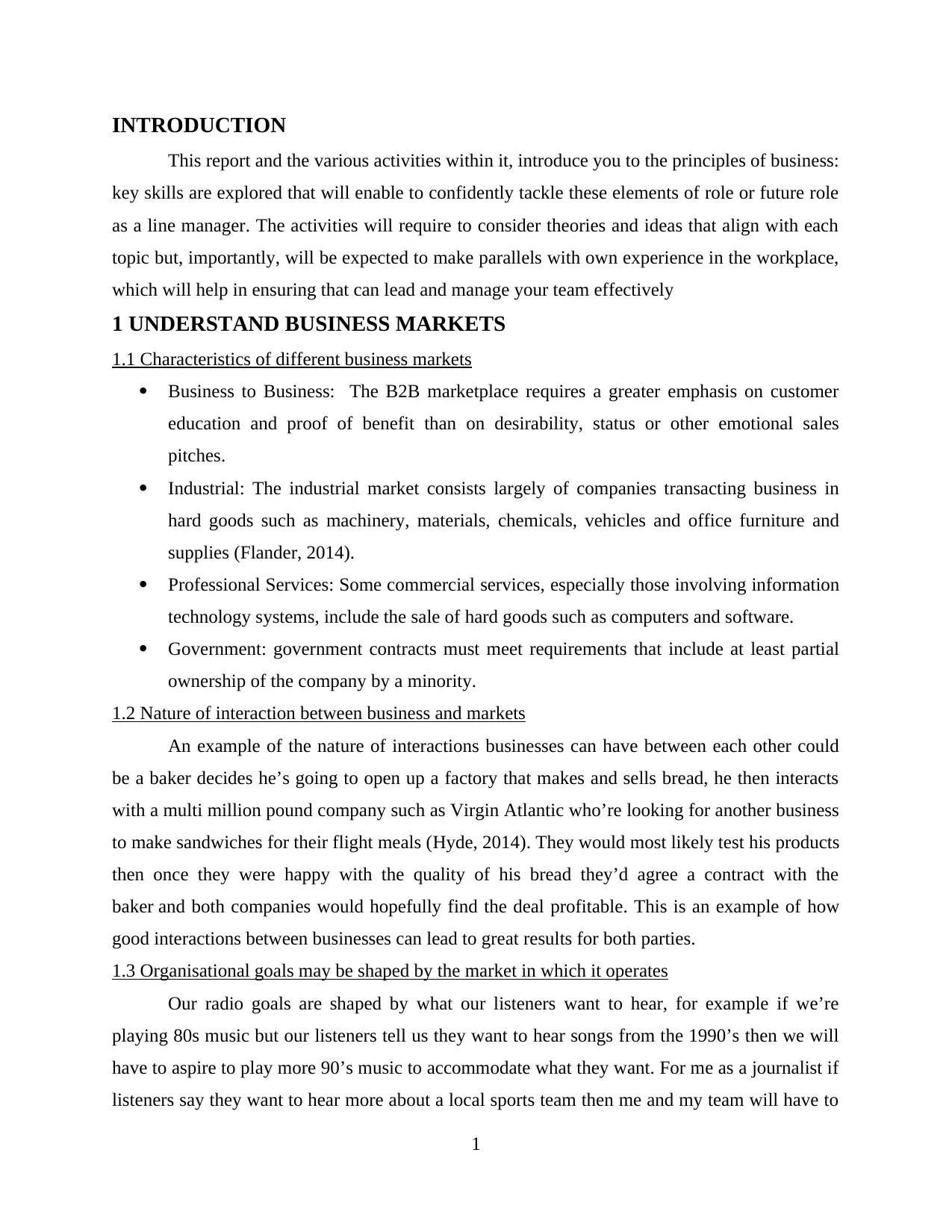
INTRODUCTION
This report and the various activities within it, introduce you to the principles of business:
key skills are explored that will enable to confidently tackle these elements of role or future role
as a line manager. The activities will require to consider theories and ideas that align with each
topic but, importantly, will be expected to make parallels with own experience in the workplace,
which will help in ensuring that can lead and manage your team effectively
1 UNDERSTAND BUSINESS MARKETS
1.1 Characteristics of different business markets
Business to Business: The B2B marketplace requires a greater emphasis on customer
education and proof of benefit than on desirability, status or other emotional sales
pitches.
Industrial: The industrial market consists largely of companies transacting business in
hard goods such as machinery, materials, chemicals, vehicles and office furniture and
supplies (Flander, 2014).
Professional Services: Some commercial services, especially those involving information
technology systems, include the sale of hard goods such as computers and software.
Government: government contracts must meet requirements that include at least partial
ownership of the company by a minority.
1.2 Nature of interaction between business and markets
An example of the nature of interactions businesses can have between each other could
be a baker decides he’s going to open up a factory that makes and sells bread, he then interacts
with a multi million pound company such as Virgin Atlantic who’re looking for another business
to make sandwiches for their flight meals (Hyde, 2014). They would most likely test his products
then once they were happy with the quality of his bread they’d agree a contract with the
baker and both companies would hopefully find the deal profitable. This is an example of how
good interactions between businesses can lead to great results for both parties.
1.3 Organisational goals may be shaped by the market in which it operates
Our radio goals are shaped by what our listeners want to hear, for example if we’re
playing 80s music but our listeners tell us they want to hear songs from the 1990’s then we will
have to aspire to play more 90’s music to accommodate what they want. For me as a journalist if
listeners say they want to hear more about a local sports team then me and my team will have to
1
This report and the various activities within it, introduce you to the principles of business:
key skills are explored that will enable to confidently tackle these elements of role or future role
as a line manager. The activities will require to consider theories and ideas that align with each
topic but, importantly, will be expected to make parallels with own experience in the workplace,
which will help in ensuring that can lead and manage your team effectively
1 UNDERSTAND BUSINESS MARKETS
1.1 Characteristics of different business markets
Business to Business: The B2B marketplace requires a greater emphasis on customer
education and proof of benefit than on desirability, status or other emotional sales
pitches.
Industrial: The industrial market consists largely of companies transacting business in
hard goods such as machinery, materials, chemicals, vehicles and office furniture and
supplies (Flander, 2014).
Professional Services: Some commercial services, especially those involving information
technology systems, include the sale of hard goods such as computers and software.
Government: government contracts must meet requirements that include at least partial
ownership of the company by a minority.
1.2 Nature of interaction between business and markets
An example of the nature of interactions businesses can have between each other could
be a baker decides he’s going to open up a factory that makes and sells bread, he then interacts
with a multi million pound company such as Virgin Atlantic who’re looking for another business
to make sandwiches for their flight meals (Hyde, 2014). They would most likely test his products
then once they were happy with the quality of his bread they’d agree a contract with the
baker and both companies would hopefully find the deal profitable. This is an example of how
good interactions between businesses can lead to great results for both parties.
1.3 Organisational goals may be shaped by the market in which it operates
Our radio goals are shaped by what our listeners want to hear, for example if we’re
playing 80s music but our listeners tell us they want to hear songs from the 1990’s then we will
have to aspire to play more 90’s music to accommodate what they want. For me as a journalist if
listeners say they want to hear more about a local sports team then me and my team will have to
1
⊘ This is a preview!⊘
Do you want full access?
Subscribe today to unlock all pages.

Trusted by 1+ million students worldwide
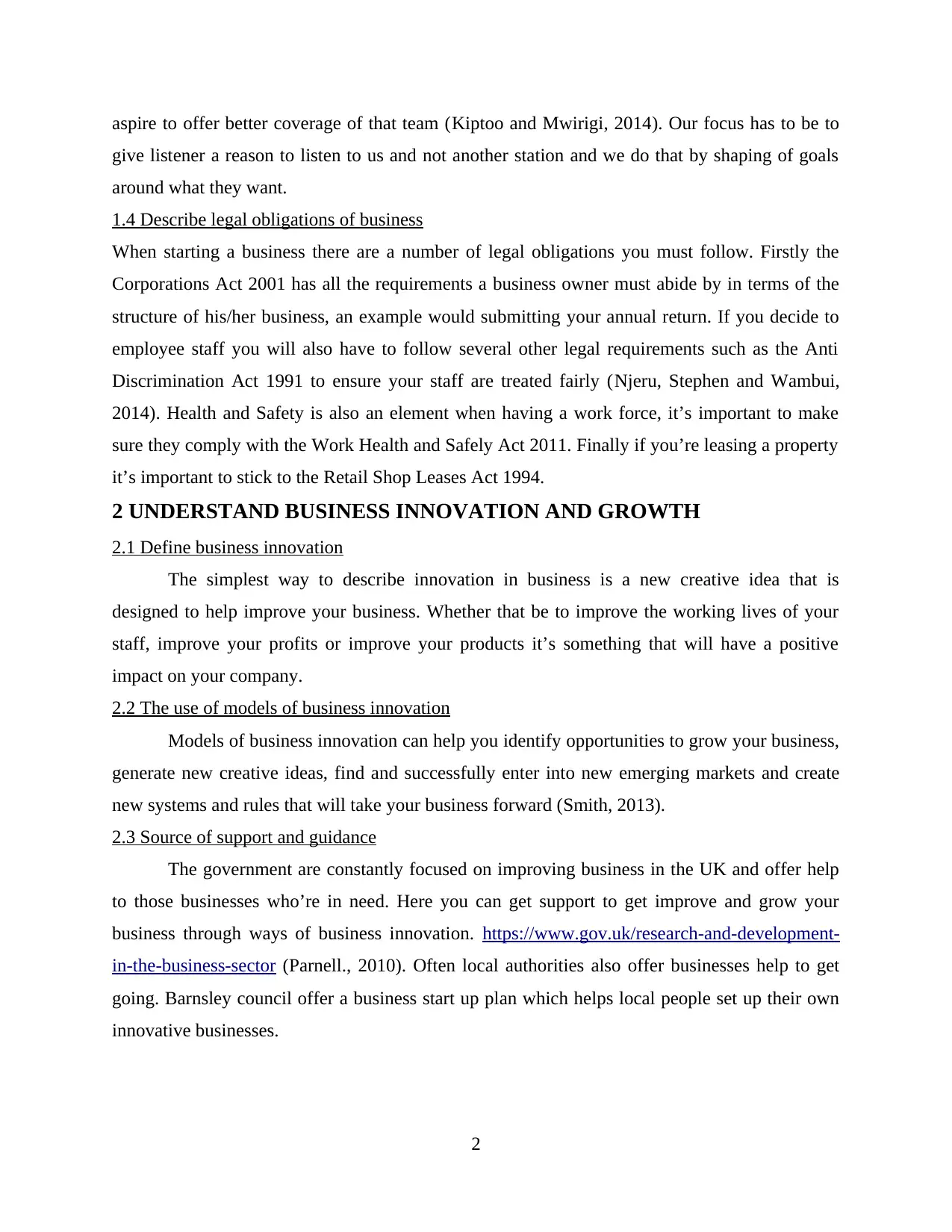
aspire to offer better coverage of that team (Kiptoo and Mwirigi, 2014). Our focus has to be to
give listener a reason to listen to us and not another station and we do that by shaping of goals
around what they want.
1.4 Describe legal obligations of business
When starting a business there are a number of legal obligations you must follow. Firstly the
Corporations Act 2001 has all the requirements a business owner must abide by in terms of the
structure of his/her business, an example would submitting your annual return. If you decide to
employee staff you will also have to follow several other legal requirements such as the Anti
Discrimination Act 1991 to ensure your staff are treated fairly (Njeru, Stephen and Wambui,
2014). Health and Safety is also an element when having a work force, it’s important to make
sure they comply with the Work Health and Safely Act 2011. Finally if you’re leasing a property
it’s important to stick to the Retail Shop Leases Act 1994.
2 UNDERSTAND BUSINESS INNOVATION AND GROWTH
2.1 Define business innovation
The simplest way to describe innovation in business is a new creative idea that is
designed to help improve your business. Whether that be to improve the working lives of your
staff, improve your profits or improve your products it’s something that will have a positive
impact on your company.
2.2 The use of models of business innovation
Models of business innovation can help you identify opportunities to grow your business,
generate new creative ideas, find and successfully enter into new emerging markets and create
new systems and rules that will take your business forward (Smith, 2013).
2.3 Source of support and guidance
The government are constantly focused on improving business in the UK and offer help
to those businesses who’re in need. Here you can get support to get improve and grow your
business through ways of business innovation. https://www.gov.uk/research-and-development-
in-the-business-sector (Parnell., 2010). Often local authorities also offer businesses help to get
going. Barnsley council offer a business start up plan which helps local people set up their own
innovative businesses.
2
give listener a reason to listen to us and not another station and we do that by shaping of goals
around what they want.
1.4 Describe legal obligations of business
When starting a business there are a number of legal obligations you must follow. Firstly the
Corporations Act 2001 has all the requirements a business owner must abide by in terms of the
structure of his/her business, an example would submitting your annual return. If you decide to
employee staff you will also have to follow several other legal requirements such as the Anti
Discrimination Act 1991 to ensure your staff are treated fairly (Njeru, Stephen and Wambui,
2014). Health and Safety is also an element when having a work force, it’s important to make
sure they comply with the Work Health and Safely Act 2011. Finally if you’re leasing a property
it’s important to stick to the Retail Shop Leases Act 1994.
2 UNDERSTAND BUSINESS INNOVATION AND GROWTH
2.1 Define business innovation
The simplest way to describe innovation in business is a new creative idea that is
designed to help improve your business. Whether that be to improve the working lives of your
staff, improve your profits or improve your products it’s something that will have a positive
impact on your company.
2.2 The use of models of business innovation
Models of business innovation can help you identify opportunities to grow your business,
generate new creative ideas, find and successfully enter into new emerging markets and create
new systems and rules that will take your business forward (Smith, 2013).
2.3 Source of support and guidance
The government are constantly focused on improving business in the UK and offer help
to those businesses who’re in need. Here you can get support to get improve and grow your
business through ways of business innovation. https://www.gov.uk/research-and-development-
in-the-business-sector (Parnell., 2010). Often local authorities also offer businesses help to get
going. Barnsley council offer a business start up plan which helps local people set up their own
innovative businesses.
2
Paraphrase This Document
Need a fresh take? Get an instant paraphrase of this document with our AI Paraphraser
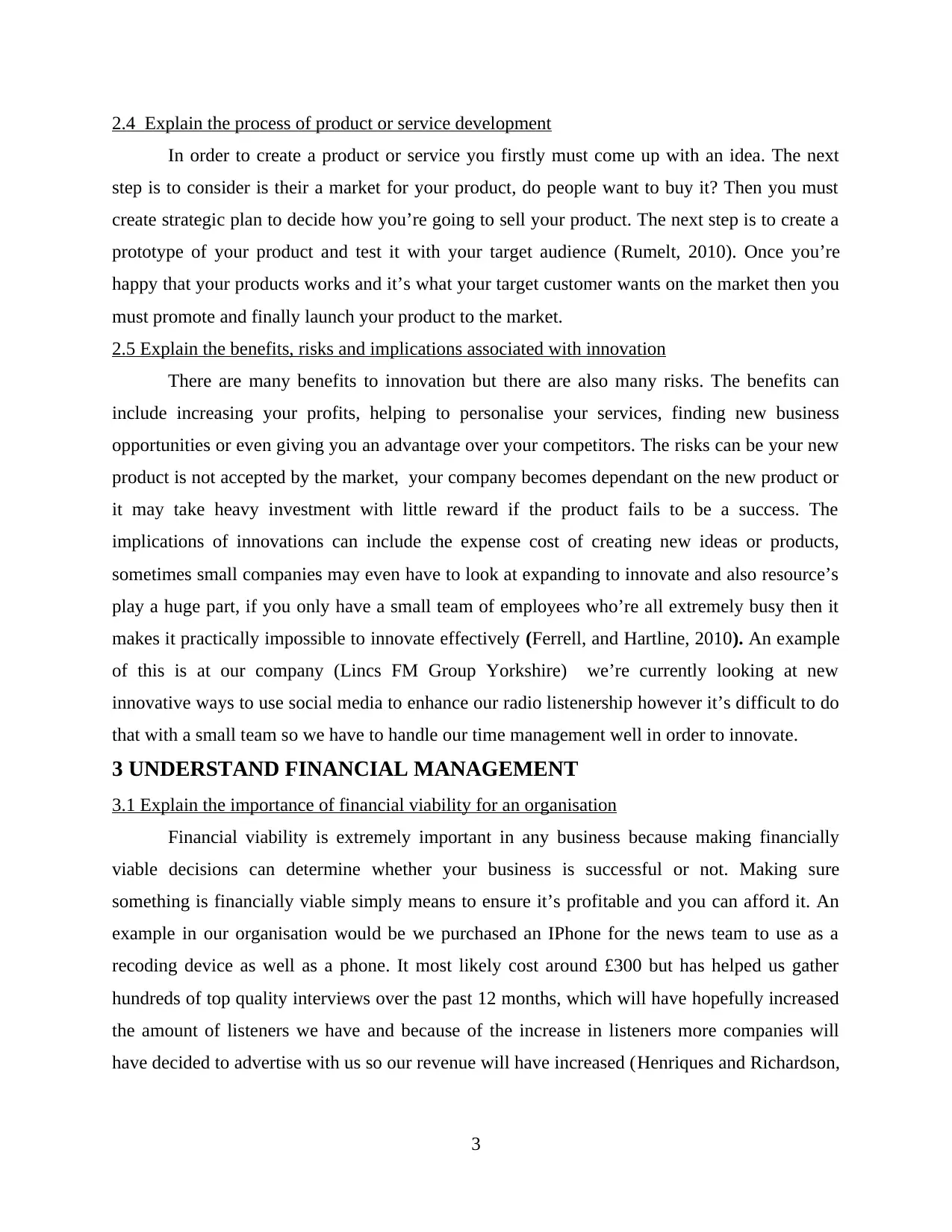
2.4 Explain the process of product or service development
In order to create a product or service you firstly must come up with an idea. The next
step is to consider is their a market for your product, do people want to buy it? Then you must
create strategic plan to decide how you’re going to sell your product. The next step is to create a
prototype of your product and test it with your target audience (Rumelt, 2010). Once you’re
happy that your products works and it’s what your target customer wants on the market then you
must promote and finally launch your product to the market.
2.5 Explain the benefits, risks and implications associated with innovation
There are many benefits to innovation but there are also many risks. The benefits can
include increasing your profits, helping to personalise your services, finding new business
opportunities or even giving you an advantage over your competitors. The risks can be your new
product is not accepted by the market, your company becomes dependant on the new product or
it may take heavy investment with little reward if the product fails to be a success. The
implications of innovations can include the expense cost of creating new ideas or products,
sometimes small companies may even have to look at expanding to innovate and also resource’s
play a huge part, if you only have a small team of employees who’re all extremely busy then it
makes it practically impossible to innovate effectively (Ferrell, and Hartline, 2010). An example
of this is at our company (Lincs FM Group Yorkshire) we’re currently looking at new
innovative ways to use social media to enhance our radio listenership however it’s difficult to do
that with a small team so we have to handle our time management well in order to innovate.
3 UNDERSTAND FINANCIAL MANAGEMENT
3.1 Explain the importance of financial viability for an organisation
Financial viability is extremely important in any business because making financially
viable decisions can determine whether your business is successful or not. Making sure
something is financially viable simply means to ensure it’s profitable and you can afford it. An
example in our organisation would be we purchased an IPhone for the news team to use as a
recoding device as well as a phone. It most likely cost around £300 but has helped us gather
hundreds of top quality interviews over the past 12 months, which will have hopefully increased
the amount of listeners we have and because of the increase in listeners more companies will
have decided to advertise with us so our revenue will have increased (Henriques and Richardson,
3
In order to create a product or service you firstly must come up with an idea. The next
step is to consider is their a market for your product, do people want to buy it? Then you must
create strategic plan to decide how you’re going to sell your product. The next step is to create a
prototype of your product and test it with your target audience (Rumelt, 2010). Once you’re
happy that your products works and it’s what your target customer wants on the market then you
must promote and finally launch your product to the market.
2.5 Explain the benefits, risks and implications associated with innovation
There are many benefits to innovation but there are also many risks. The benefits can
include increasing your profits, helping to personalise your services, finding new business
opportunities or even giving you an advantage over your competitors. The risks can be your new
product is not accepted by the market, your company becomes dependant on the new product or
it may take heavy investment with little reward if the product fails to be a success. The
implications of innovations can include the expense cost of creating new ideas or products,
sometimes small companies may even have to look at expanding to innovate and also resource’s
play a huge part, if you only have a small team of employees who’re all extremely busy then it
makes it practically impossible to innovate effectively (Ferrell, and Hartline, 2010). An example
of this is at our company (Lincs FM Group Yorkshire) we’re currently looking at new
innovative ways to use social media to enhance our radio listenership however it’s difficult to do
that with a small team so we have to handle our time management well in order to innovate.
3 UNDERSTAND FINANCIAL MANAGEMENT
3.1 Explain the importance of financial viability for an organisation
Financial viability is extremely important in any business because making financially
viable decisions can determine whether your business is successful or not. Making sure
something is financially viable simply means to ensure it’s profitable and you can afford it. An
example in our organisation would be we purchased an IPhone for the news team to use as a
recoding device as well as a phone. It most likely cost around £300 but has helped us gather
hundreds of top quality interviews over the past 12 months, which will have hopefully increased
the amount of listeners we have and because of the increase in listeners more companies will
have decided to advertise with us so our revenue will have increased (Henriques and Richardson,
3
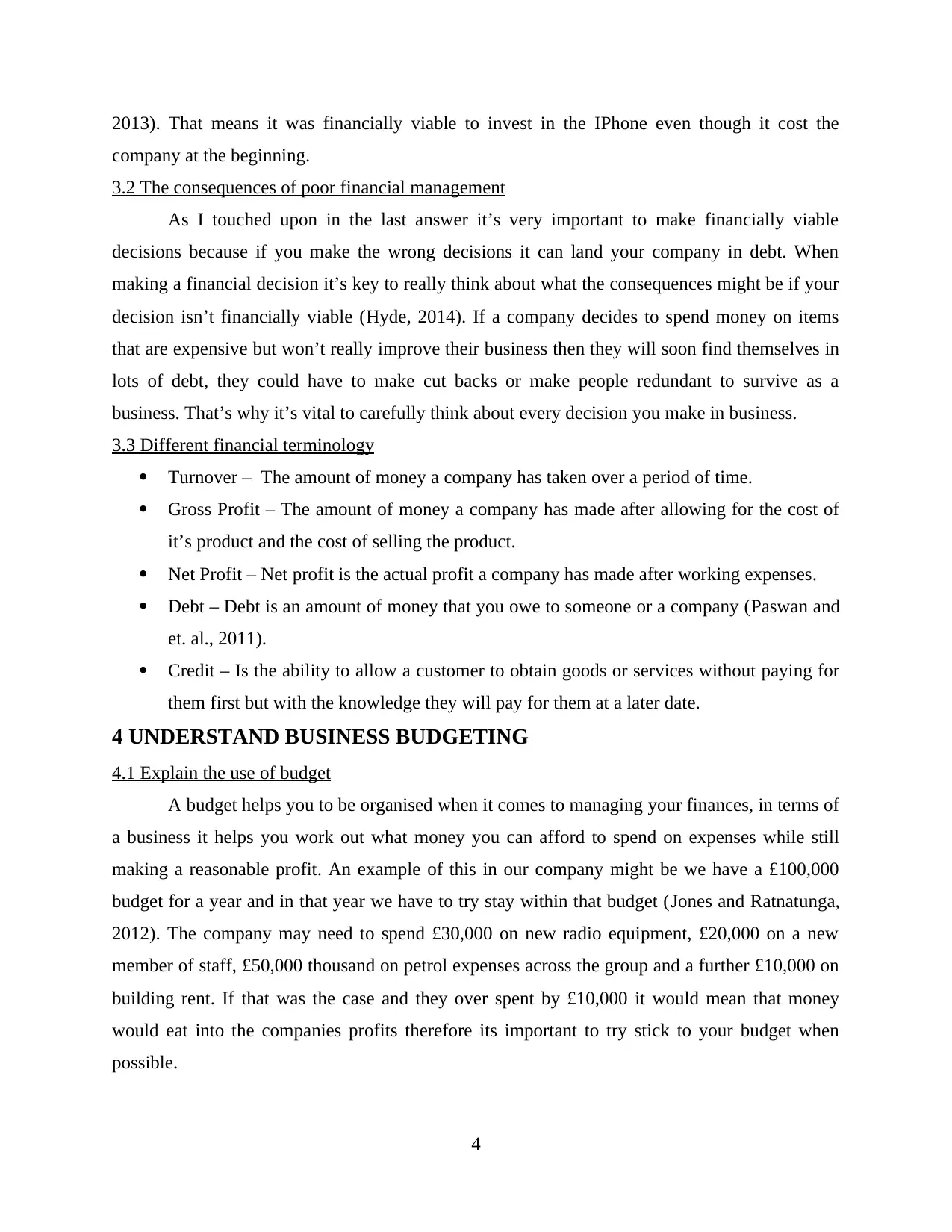
2013). That means it was financially viable to invest in the IPhone even though it cost the
company at the beginning.
3.2 The consequences of poor financial management
As I touched upon in the last answer it’s very important to make financially viable
decisions because if you make the wrong decisions it can land your company in debt. When
making a financial decision it’s key to really think about what the consequences might be if your
decision isn’t financially viable (Hyde, 2014). If a company decides to spend money on items
that are expensive but won’t really improve their business then they will soon find themselves in
lots of debt, they could have to make cut backs or make people redundant to survive as a
business. That’s why it’s vital to carefully think about every decision you make in business.
3.3 Different financial terminology
Turnover – The amount of money a company has taken over a period of time.
Gross Profit – The amount of money a company has made after allowing for the cost of
it’s product and the cost of selling the product.
Net Profit – Net profit is the actual profit a company has made after working expenses.
Debt – Debt is an amount of money that you owe to someone or a company (Paswan and
et. al., 2011).
Credit – Is the ability to allow a customer to obtain goods or services without paying for
them first but with the knowledge they will pay for them at a later date.
4 UNDERSTAND BUSINESS BUDGETING
4.1 Explain the use of budget
A budget helps you to be organised when it comes to managing your finances, in terms of
a business it helps you work out what money you can afford to spend on expenses while still
making a reasonable profit. An example of this in our company might be we have a £100,000
budget for a year and in that year we have to try stay within that budget (Jones and Ratnatunga,
2012). The company may need to spend £30,000 on new radio equipment, £20,000 on a new
member of staff, £50,000 thousand on petrol expenses across the group and a further £10,000 on
building rent. If that was the case and they over spent by £10,000 it would mean that money
would eat into the companies profits therefore its important to try stick to your budget when
possible.
4
company at the beginning.
3.2 The consequences of poor financial management
As I touched upon in the last answer it’s very important to make financially viable
decisions because if you make the wrong decisions it can land your company in debt. When
making a financial decision it’s key to really think about what the consequences might be if your
decision isn’t financially viable (Hyde, 2014). If a company decides to spend money on items
that are expensive but won’t really improve their business then they will soon find themselves in
lots of debt, they could have to make cut backs or make people redundant to survive as a
business. That’s why it’s vital to carefully think about every decision you make in business.
3.3 Different financial terminology
Turnover – The amount of money a company has taken over a period of time.
Gross Profit – The amount of money a company has made after allowing for the cost of
it’s product and the cost of selling the product.
Net Profit – Net profit is the actual profit a company has made after working expenses.
Debt – Debt is an amount of money that you owe to someone or a company (Paswan and
et. al., 2011).
Credit – Is the ability to allow a customer to obtain goods or services without paying for
them first but with the knowledge they will pay for them at a later date.
4 UNDERSTAND BUSINESS BUDGETING
4.1 Explain the use of budget
A budget helps you to be organised when it comes to managing your finances, in terms of
a business it helps you work out what money you can afford to spend on expenses while still
making a reasonable profit. An example of this in our company might be we have a £100,000
budget for a year and in that year we have to try stay within that budget (Jones and Ratnatunga,
2012). The company may need to spend £30,000 on new radio equipment, £20,000 on a new
member of staff, £50,000 thousand on petrol expenses across the group and a further £10,000 on
building rent. If that was the case and they over spent by £10,000 it would mean that money
would eat into the companies profits therefore its important to try stick to your budget when
possible.
4
⊘ This is a preview!⊘
Do you want full access?
Subscribe today to unlock all pages.

Trusted by 1+ million students worldwide
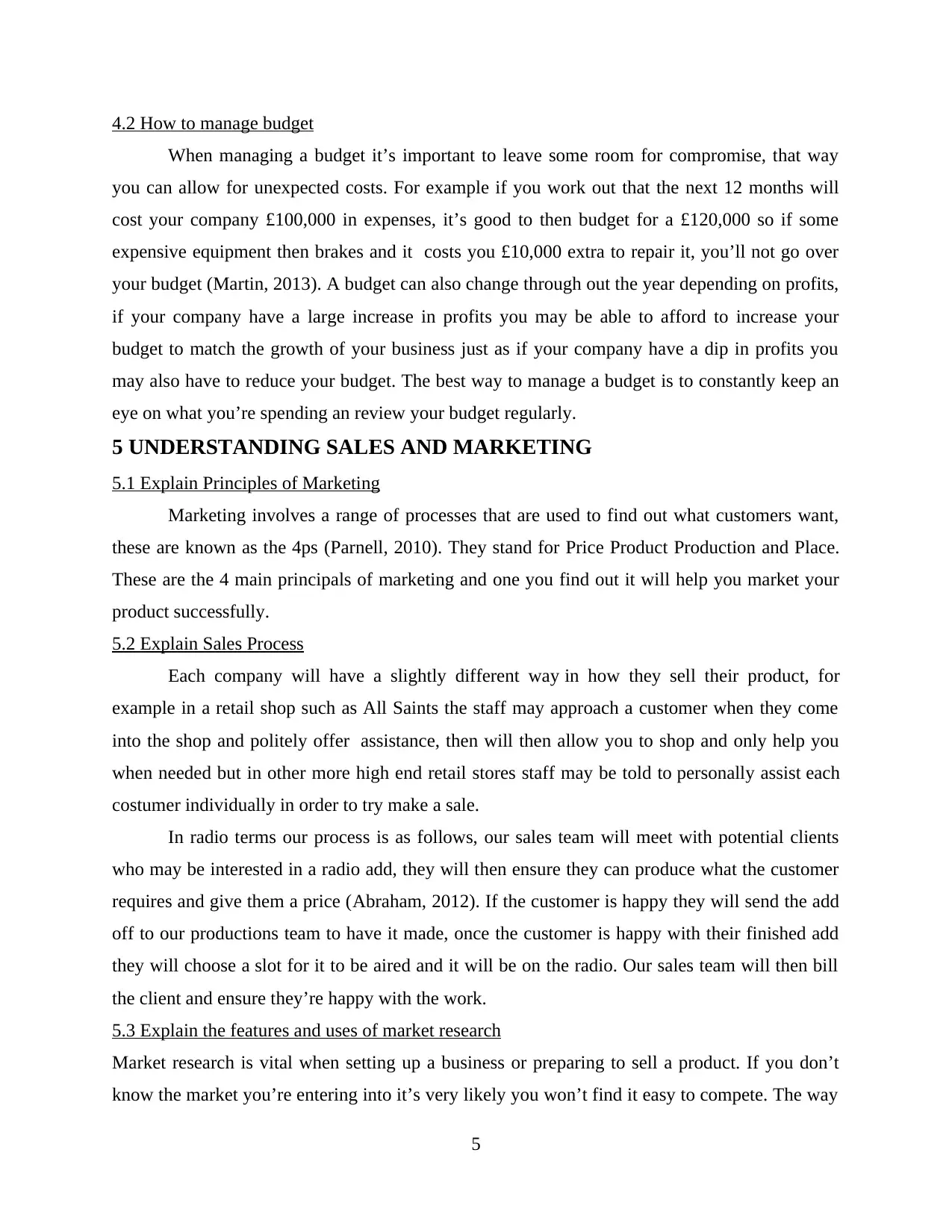
4.2 How to manage budget
When managing a budget it’s important to leave some room for compromise, that way
you can allow for unexpected costs. For example if you work out that the next 12 months will
cost your company £100,000 in expenses, it’s good to then budget for a £120,000 so if some
expensive equipment then brakes and it costs you £10,000 extra to repair it, you’ll not go over
your budget (Martin, 2013). A budget can also change through out the year depending on profits,
if your company have a large increase in profits you may be able to afford to increase your
budget to match the growth of your business just as if your company have a dip in profits you
may also have to reduce your budget. The best way to manage a budget is to constantly keep an
eye on what you’re spending an review your budget regularly.
5 UNDERSTANDING SALES AND MARKETING
5.1 Explain Principles of Marketing
Marketing involves a range of processes that are used to find out what customers want,
these are known as the 4ps (Parnell, 2010). They stand for Price Product Production and Place.
These are the 4 main principals of marketing and one you find out it will help you market your
product successfully.
5.2 Explain Sales Process
Each company will have a slightly different way in how they sell their product, for
example in a retail shop such as All Saints the staff may approach a customer when they come
into the shop and politely offer assistance, then will then allow you to shop and only help you
when needed but in other more high end retail stores staff may be told to personally assist each
costumer individually in order to try make a sale.
In radio terms our process is as follows, our sales team will meet with potential clients
who may be interested in a radio add, they will then ensure they can produce what the customer
requires and give them a price (Abraham, 2012). If the customer is happy they will send the add
off to our productions team to have it made, once the customer is happy with their finished add
they will choose a slot for it to be aired and it will be on the radio. Our sales team will then bill
the client and ensure they’re happy with the work.
5.3 Explain the features and uses of market research
Market research is vital when setting up a business or preparing to sell a product. If you don’t
know the market you’re entering into it’s very likely you won’t find it easy to compete. The way
5
When managing a budget it’s important to leave some room for compromise, that way
you can allow for unexpected costs. For example if you work out that the next 12 months will
cost your company £100,000 in expenses, it’s good to then budget for a £120,000 so if some
expensive equipment then brakes and it costs you £10,000 extra to repair it, you’ll not go over
your budget (Martin, 2013). A budget can also change through out the year depending on profits,
if your company have a large increase in profits you may be able to afford to increase your
budget to match the growth of your business just as if your company have a dip in profits you
may also have to reduce your budget. The best way to manage a budget is to constantly keep an
eye on what you’re spending an review your budget regularly.
5 UNDERSTANDING SALES AND MARKETING
5.1 Explain Principles of Marketing
Marketing involves a range of processes that are used to find out what customers want,
these are known as the 4ps (Parnell, 2010). They stand for Price Product Production and Place.
These are the 4 main principals of marketing and one you find out it will help you market your
product successfully.
5.2 Explain Sales Process
Each company will have a slightly different way in how they sell their product, for
example in a retail shop such as All Saints the staff may approach a customer when they come
into the shop and politely offer assistance, then will then allow you to shop and only help you
when needed but in other more high end retail stores staff may be told to personally assist each
costumer individually in order to try make a sale.
In radio terms our process is as follows, our sales team will meet with potential clients
who may be interested in a radio add, they will then ensure they can produce what the customer
requires and give them a price (Abraham, 2012). If the customer is happy they will send the add
off to our productions team to have it made, once the customer is happy with their finished add
they will choose a slot for it to be aired and it will be on the radio. Our sales team will then bill
the client and ensure they’re happy with the work.
5.3 Explain the features and uses of market research
Market research is vital when setting up a business or preparing to sell a product. If you don’t
know the market you’re entering into it’s very likely you won’t find it easy to compete. The way
5
Paraphrase This Document
Need a fresh take? Get an instant paraphrase of this document with our AI Paraphraser
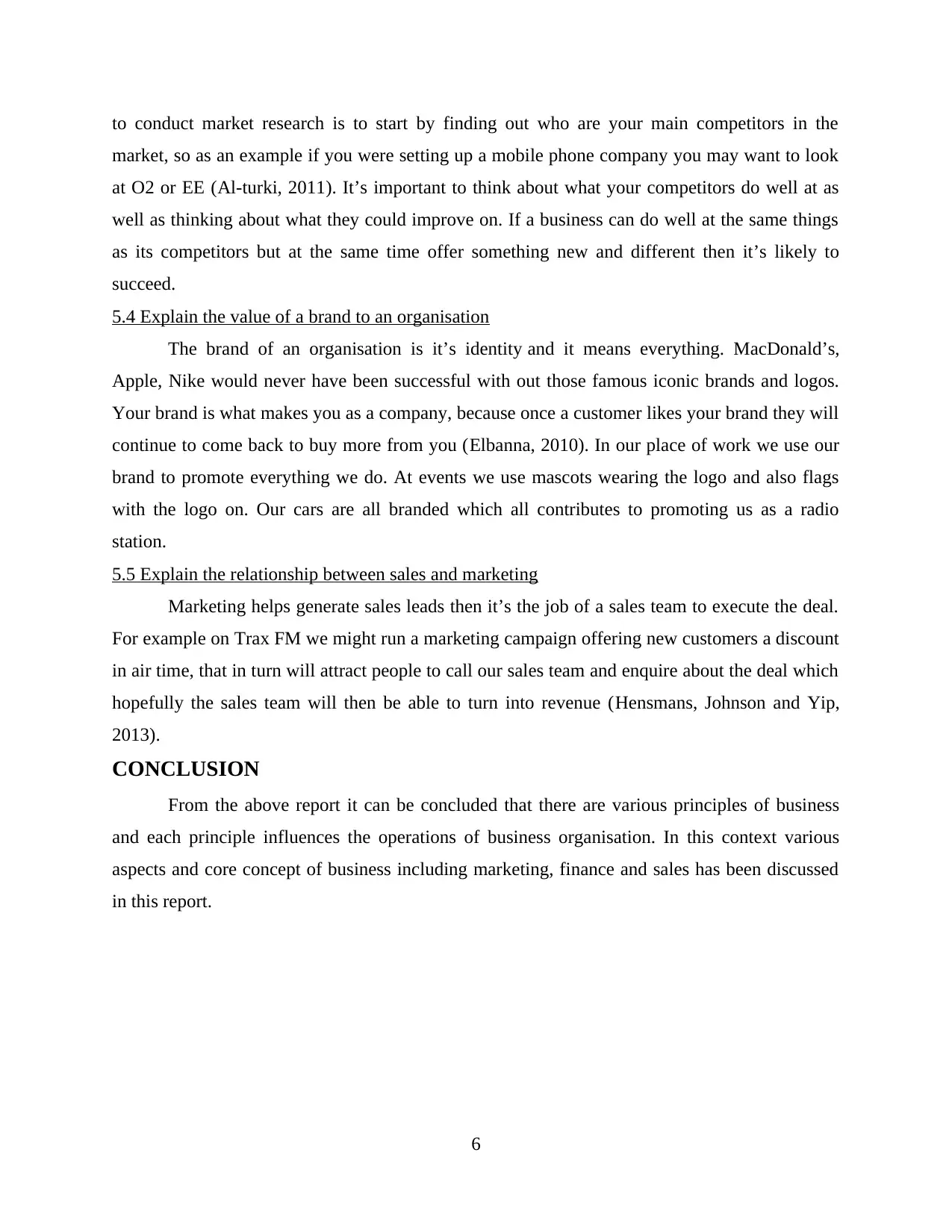
to conduct market research is to start by finding out who are your main competitors in the
market, so as an example if you were setting up a mobile phone company you may want to look
at O2 or EE (Al-turki, 2011). It’s important to think about what your competitors do well at as
well as thinking about what they could improve on. If a business can do well at the same things
as its competitors but at the same time offer something new and different then it’s likely to
succeed.
5.4 Explain the value of a brand to an organisation
The brand of an organisation is it’s identity and it means everything. MacDonald’s,
Apple, Nike would never have been successful with out those famous iconic brands and logos.
Your brand is what makes you as a company, because once a customer likes your brand they will
continue to come back to buy more from you (Elbanna, 2010). In our place of work we use our
brand to promote everything we do. At events we use mascots wearing the logo and also flags
with the logo on. Our cars are all branded which all contributes to promoting us as a radio
station.
5.5 Explain the relationship between sales and marketing
Marketing helps generate sales leads then it’s the job of a sales team to execute the deal.
For example on Trax FM we might run a marketing campaign offering new customers a discount
in air time, that in turn will attract people to call our sales team and enquire about the deal which
hopefully the sales team will then be able to turn into revenue (Hensmans, Johnson and Yip,
2013).
CONCLUSION
From the above report it can be concluded that there are various principles of business
and each principle influences the operations of business organisation. In this context various
aspects and core concept of business including marketing, finance and sales has been discussed
in this report.
6
market, so as an example if you were setting up a mobile phone company you may want to look
at O2 or EE (Al-turki, 2011). It’s important to think about what your competitors do well at as
well as thinking about what they could improve on. If a business can do well at the same things
as its competitors but at the same time offer something new and different then it’s likely to
succeed.
5.4 Explain the value of a brand to an organisation
The brand of an organisation is it’s identity and it means everything. MacDonald’s,
Apple, Nike would never have been successful with out those famous iconic brands and logos.
Your brand is what makes you as a company, because once a customer likes your brand they will
continue to come back to buy more from you (Elbanna, 2010). In our place of work we use our
brand to promote everything we do. At events we use mascots wearing the logo and also flags
with the logo on. Our cars are all branded which all contributes to promoting us as a radio
station.
5.5 Explain the relationship between sales and marketing
Marketing helps generate sales leads then it’s the job of a sales team to execute the deal.
For example on Trax FM we might run a marketing campaign offering new customers a discount
in air time, that in turn will attract people to call our sales team and enquire about the deal which
hopefully the sales team will then be able to turn into revenue (Hensmans, Johnson and Yip,
2013).
CONCLUSION
From the above report it can be concluded that there are various principles of business
and each principle influences the operations of business organisation. In this context various
aspects and core concept of business including marketing, finance and sales has been discussed
in this report.
6
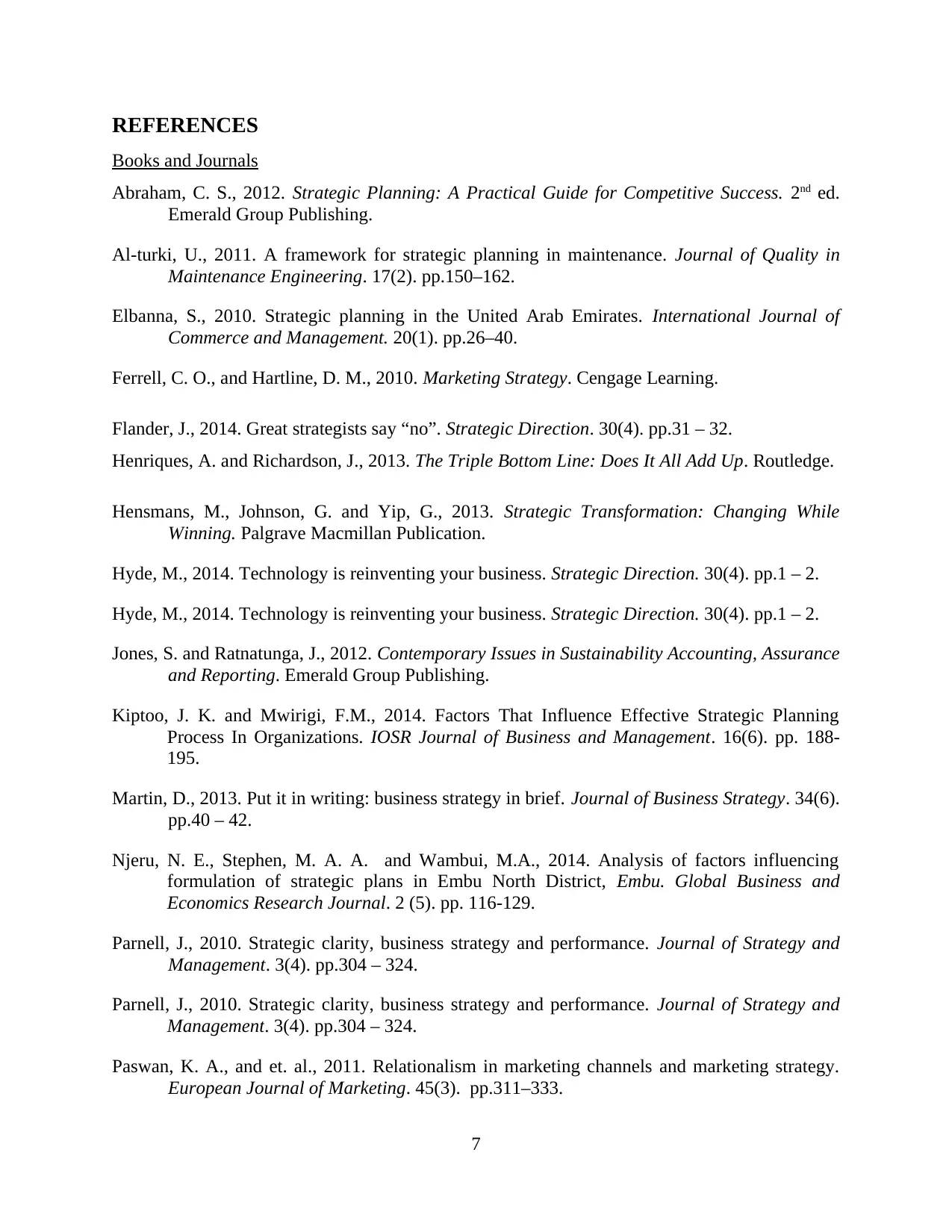
REFERENCES
Books and Journals
Abraham, C. S., 2012. Strategic Planning: A Practical Guide for Competitive Success. 2nd ed.
Emerald Group Publishing.
Al-turki, U., 2011. A framework for strategic planning in maintenance. Journal of Quality in
Maintenance Engineering. 17(2). pp.150–162.
Elbanna, S., 2010. Strategic planning in the United Arab Emirates. International Journal of
Commerce and Management. 20(1). pp.26–40.
Ferrell, C. O., and Hartline, D. M., 2010. Marketing Strategy. Cengage Learning.
Flander, J., 2014. Great strategists say “no”. Strategic Direction. 30(4). pp.31 – 32.
Henriques, A. and Richardson, J., 2013. The Triple Bottom Line: Does It All Add Up. Routledge.
Hensmans, M., Johnson, G. and Yip, G., 2013. Strategic Transformation: Changing While
Winning. Palgrave Macmillan Publication.
Hyde, M., 2014. Technology is reinventing your business. Strategic Direction. 30(4). pp.1 – 2.
Hyde, M., 2014. Technology is reinventing your business. Strategic Direction. 30(4). pp.1 – 2.
Jones, S. and Ratnatunga, J., 2012. Contemporary Issues in Sustainability Accounting, Assurance
and Reporting. Emerald Group Publishing.
Kiptoo, J. K. and Mwirigi, F.M., 2014. Factors That Influence Effective Strategic Planning
Process In Organizations. IOSR Journal of Business and Management. 16(6). pp. 188-
195.
Martin, D., 2013. Put it in writing: business strategy in brief. Journal of Business Strategy. 34(6).
pp.40 – 42.
Njeru, N. E., Stephen, M. A. A. and Wambui, M.A., 2014. Analysis of factors influencing
formulation of strategic plans in Embu North District, Embu. Global Business and
Economics Research Journal. 2 (5). pp. 116-129.
Parnell, J., 2010. Strategic clarity, business strategy and performance. Journal of Strategy and
Management. 3(4). pp.304 – 324.
Parnell, J., 2010. Strategic clarity, business strategy and performance. Journal of Strategy and
Management. 3(4). pp.304 – 324.
Paswan, K. A., and et. al., 2011. Relationalism in marketing channels and marketing strategy.
European Journal of Marketing. 45(3). pp.311–333.
7
Books and Journals
Abraham, C. S., 2012. Strategic Planning: A Practical Guide for Competitive Success. 2nd ed.
Emerald Group Publishing.
Al-turki, U., 2011. A framework for strategic planning in maintenance. Journal of Quality in
Maintenance Engineering. 17(2). pp.150–162.
Elbanna, S., 2010. Strategic planning in the United Arab Emirates. International Journal of
Commerce and Management. 20(1). pp.26–40.
Ferrell, C. O., and Hartline, D. M., 2010. Marketing Strategy. Cengage Learning.
Flander, J., 2014. Great strategists say “no”. Strategic Direction. 30(4). pp.31 – 32.
Henriques, A. and Richardson, J., 2013. The Triple Bottom Line: Does It All Add Up. Routledge.
Hensmans, M., Johnson, G. and Yip, G., 2013. Strategic Transformation: Changing While
Winning. Palgrave Macmillan Publication.
Hyde, M., 2014. Technology is reinventing your business. Strategic Direction. 30(4). pp.1 – 2.
Hyde, M., 2014. Technology is reinventing your business. Strategic Direction. 30(4). pp.1 – 2.
Jones, S. and Ratnatunga, J., 2012. Contemporary Issues in Sustainability Accounting, Assurance
and Reporting. Emerald Group Publishing.
Kiptoo, J. K. and Mwirigi, F.M., 2014. Factors That Influence Effective Strategic Planning
Process In Organizations. IOSR Journal of Business and Management. 16(6). pp. 188-
195.
Martin, D., 2013. Put it in writing: business strategy in brief. Journal of Business Strategy. 34(6).
pp.40 – 42.
Njeru, N. E., Stephen, M. A. A. and Wambui, M.A., 2014. Analysis of factors influencing
formulation of strategic plans in Embu North District, Embu. Global Business and
Economics Research Journal. 2 (5). pp. 116-129.
Parnell, J., 2010. Strategic clarity, business strategy and performance. Journal of Strategy and
Management. 3(4). pp.304 – 324.
Parnell, J., 2010. Strategic clarity, business strategy and performance. Journal of Strategy and
Management. 3(4). pp.304 – 324.
Paswan, K. A., and et. al., 2011. Relationalism in marketing channels and marketing strategy.
European Journal of Marketing. 45(3). pp.311–333.
7
⊘ This is a preview!⊘
Do you want full access?
Subscribe today to unlock all pages.

Trusted by 1+ million students worldwide

Rumelt, R. P., 2010. Towards a strategic theory of the firm. Competitive strategic management.
26. pp.556-570.
Smith, D. R., 2013. Strategic Planning for Public Relations, Fourth Edition. 4th ed. Routledge
Publications.
8
26. pp.556-570.
Smith, D. R., 2013. Strategic Planning for Public Relations, Fourth Edition. 4th ed. Routledge
Publications.
8
1 out of 10
Related Documents
Your All-in-One AI-Powered Toolkit for Academic Success.
+13062052269
info@desklib.com
Available 24*7 on WhatsApp / Email
![[object Object]](/_next/static/media/star-bottom.7253800d.svg)
Unlock your academic potential
Copyright © 2020–2025 A2Z Services. All Rights Reserved. Developed and managed by ZUCOL.





